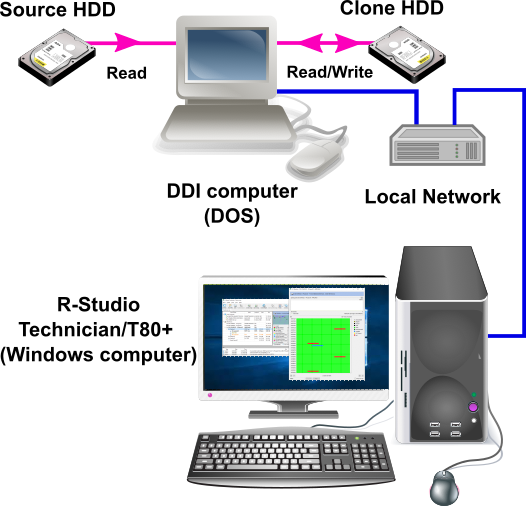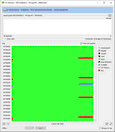





- Contents
- Index
- A -
Apple CoreStorage/FileVault/Fusion Drive Volumes
- B -
Bad Sectors settings
Set default read retries count for all drives
Binary (byte to byte copy)
BitLocker System Drive Encryption
Broken File Name
Rename and change all invalid symbols to:
Broken File Name options
Button
Buttons
Create virtual volume sets or RAIDs
- C -
Connect to R-Studio settings
Allow connection from any address
Allow connection from the host
Connecting to DeepSpar Disk Imager™ manually
Contact information and technical support
Create menu
Create Virtual Block RAID & Autodetect
Creating and saving your own RAID configuration
Creating Startup Disks for Mac and Linux Computers
- D -
Data Copy in Text/hexadecimal editor
Data Recovery on HFS/HFS+ File System
Connect to the remote computer
Description Files for RAID Configuration
Devices to Store Recovered Files
Dialog box
Dialog boxes
Edit Block RAID Layout Presets
Please configure R-Studio Agent for Mac
Please configure R-Studio Agent for Windows
R-Studio Agent for Linux Configuration
There is not enough space on the disk
Drive menu
- E -
Edit menu
Find Template Signature Previous
Editor tabs
Exclusive Region options
- F -
Fast Search for Lost Partitions
File Already Exists
File Information (R-Studio Technician/T80+)
File mask options
File menu
File Systems settings
Default encoding for Ext2/Ext3/Ext4/UFS volumes
Default encoding for HFS volumes
File Type Signature Specification
File Types
Find options
Find/mark objects only in real paths, ignore links to folders
Find/Mark options
Finding Previous File Versions
Forensic Data Collection Audit Log
- H -
Help menu
Hidden Attribute
- I -
Image options
Image type:
Byte to byte image to a physical disk
Compressed image (R-Drive Image compatible)
VMDK (VmWare Virtual Machine Disk)
- K -
Known File Types settings
- L -
Log settings
Maximum messages in the Event Log
- M -
Main settings
Reset all hidden notifications
Limit usage of the process memory by
Messages
Double-click a logical disk...
Mount options
Mounting Virtual Objects in the System
- N -
Nested and Non-Standard RAID Levels
- O -
Opening several disks/partitions in one tab
Opening Virtual Disks from the Files Panel
- P -
Panels
Panes
Portable version of R-Studio Technician
Properties tab
- Q -
- R -
Recover options
Condense successful restoration events:
Do not recover duplicate files from Extra Found Files
Open local folder (folders) when done
Recover alternative data streams:
Recover real folders structure
Recovered only masked marked files
Region options
Contact information and technical support
Installing R-Studio Agent Emergency Startup Media Creator
Starting a Computer with the R-Studio Agent Emergency Startup Disk
R-Studio Agent for Mac main panel
R-Studio Agent for Windows main panel
Contact Informaiton and Technical Support
Installing R-Studio Emergency Startup Media Creator
Properties and Text/Hexadecimal Viewer
Starting a Computer with the R-Studio Emergency Startup Disks
R-Studio Emergency Startup Media Creator
- S -
Scan options
Search options
Settings
Shortcut menu
Find Previous Versions of the File
Find Template Signature Previous
Remove All Scanned Information
Smart drive copy
Copy all partitions onto original places
Expand/Shrink partition to whole drive
Smart partition copy
Startup Media Troubleshooting Options
Don't show symbolic links by default (Technician version)
Recovery as it is (Technician version)
Show folder symbolic links as links to their targets, without target content (Technician version)
Symbolic links display settings
Symbolic links recovery options
Syntaxis of a Description File for RAID Configurations
- T -
Tabs
Technical Information and Troubleshooting
Tools menu
- U -
- V -
View menu
Virtual Disk Formats
Volume Sets, Stripe Sets, and Mirrors
- W -
Window
Working with RAID 6 Presets
DeepSpar Disk Imager™
DeepSpar Disk Imager™ ( DDI ) is an HDD imaging device specifically built for data recovery from drives with hardware issues. It greatly increases imaging speed, accuracy, and integrity of data retrieved from such drives.
The main features that DDI provides when working with drives are the following:
• Direct low-level access to a drive bypassing the computers BIOS.
• Disabling specific drive read/write heads.
• Disable SMART subsystem, Bad Sector Reallocation, and Read Look-Ahead
• Read sector timeout controlled by Software/Hardware/PHY drive reset commands
• Bit level analysis of corrupted data to filter out the read-write channel noise
• Fully customizable multi-pass imaging
And many more others an advanced drive imager must have.
DeepSpar Disk Imager™ basics
The main idea of data recovery with DDI is to clone data from the source drive with a certain level of hardware malfunction to a clone drive and perform data recovery operations either from the clone drive or while data is being cloned. Such approach greatly reduces tear and wear of the source drive and reduces further deterioration of its state.
There are two modes in which DDI processes drive s:
• DDI clones the entire source drive to the source one consequently, sector by sector. Any further data recovery will be made from the clone HDD.
• DDI clones those sectors of the source HDD which have been read during data recovery. Such readings are optimized to minimize the movement of the drive's head unit. All following reads from those sectors will be done from the clone drive . For example, if files are to be recovered from a partition on the drive, DDI will clone the boot record of the drive, the file table of the partition, and the sectors of the files. If the partition is scanned, the scanned sectors will be cloned, too. All consecutive operations, such as file preview, and so on, will be done from the clone drive . This greatly reduces the time necessary to perform the recovery operations and furthermore drive wear.
Read the DDI documentation on how to install DDI connect the drives to DDI and start working with it.
The DDI board should be installed into a separate network computer (the DDI computer ), and the source and clone drives should be connected to it. The DDI computer should be started using the boot USB stick supplied with the board. R‑Studio running on another computer (the R‑Studio computer ) accesses the drive via the network. All data recovery operations will be done through this setup:

There may be several DDI computers on the network, R‑Studio will connect to all of them. Such configuration may be useful for RAID recovery when several drive s on the RAID have hardware problems.
Working with DDI
To start working with DDI , its computer should be connected to R‑Studio .
Check that the Enable DeepSpar device option is selected on the Main tab of the Settings dialog box
To connect R‑Studio to the DDI computer,
| * | Select Connect to DDI on the Drive menu |
| > | The drive s connected to DDI will appear in the Drive pane. |
Now it is possible to work with drive s connected to DDI like all other drive objects in the Drive panel. For example, such drive s may be included into virtual RAIDs and other compound objects.
Viewing the drive map
A drive map shows the conditions for individual drive sectors. You may see which sectors are OK, bad, or unstable.
To view the drive map,
| * | Right-click the required drive/partition and select I/O Monitor on the shortcut menu, |
or
select the object and select I/O Monitor on the Drive menu
| > | The drive map will appear in the I/O Monitor window. |
You may also image individual files and view file maps .
R‑Studio can also load and process images created with the DeepSpar Disk Imager™ .
Connecting to DeepSpar Disk Imager™ manually
If R‑Studio cannot find DeepSpar Disk Imager™ , the Select Interface dialog box will appear. Try to find the DDI interface manually.
You may disable/enable work with DeepSpar Disk Imager™ on the Main tab of the Settings panel. You need to restart R‑Studio for the changes to take effect.
- R-Studio Technician: activation using a USB stick
- Data Recovery Guide
- Why R-Studio?
- R-Studio for Forensic and Data Recovery Business
- R-STUDIO Review on TopTenReviews
- File Recovery Specifics for SSD devices
- How to recover data from NVMe devices
- Predicting Success of Common Data Recovery Cases
- Recovery of Overwritten Data
- Emergency File Recovery Using R-Studio Emergency
- RAID Recovery Presentation
- R-Studio: Data recovery from a non-functional computer
- File Recovery from a Computer that Won't Boot
- Clone Disks Before File Recovery
- HD Video Recovery from SD cards
- File Recovery from an Unbootable Mac Computer
- The best way to recover files from a Mac system disk
- Data Recovery from an Encrypted Linux Disk after a System Crash
- Data Recovery from Apple Disk Images (.DMG files)
- File Recovery after Re-installing Windows
- R-Studio: Data Recovery over Network
- How To Use R-Studio Corporate Package
- Data Recovery from a Re-Formatted NTFS Disk
- Data Recovery from an ReFS disk
- Data Recovery from a Re-Formatted exFAT/FAT Disk
- Data Recovery from an Erased HFS Disk
- Data Recovery from an Erased APFS Disk
- Data Recovery from a Re-Formatted Ext2/3/4FS Disk
- Data Recovery from an XFS Disk
- Data Recovery from a Simple NAS
- How to connect virtual RAID and LVM/LDM volumes to the operating system
- Specifics of File Recovery After a Quick Format
- Data Recovery After Partition Manager Crash
- File Recovery vs. File Repair
- Data Recovery from Virtual Machines
- How to Connect Disks to a Computer
- Emergency Data Recovery over Network
- Data Recovery over the Internet
- Creating a Custom Known File Type for R-Studio
- Finding RAID parameters
- Recovering Partitions on a Damaged Disk
- NAT and Firewall Traversal for Remote Data Recovery
- Data Recovery from an External Disk with a Damaged File System
- File Recovery Basics
- Default Parameters of Software Stripe Sets (RAID 0) in Mac OS X
- Data Recovery from Virtual Hard Disk (VHD/VHDX) Files
- Data Recovery from Various File Container Formats and Encrypted Disks
- Automatic RAID Parameter Detection
- IntelligentScan Data Recovery Technology
- Multi-pass imaging in R-Studio
- Runtime Imaging in R-Studio
- Linear Imaging vs Runtime Imaging vs Multi-Pass Imaging
- USB Stabilizer Tech for unstable USB devices
- Joint work of R-Studio and PC-3000 UDMA hardware
- Joint work of R-Studio and HDDSuperClone
- R-Studio T80+ - A Professional Data Recovery and Forensic Solution for Small Business and Individuals Just for 1 USD/day
- Backup Articles
- R-Drive Image Standalone and Corporate license transferring
- Fixing Windows update error 0x80070643 with R-Drive Image
- Backup with Confidence
- R-Drive Image as a free powerful partition manager
- Computer Recovery and System Restore
- Disk Cloning and Mass System Deployment
- Accessing Individual Files or Folders on a Backed Up Disk Image
- R-Drive Image startup / bootable version
- File Backup for Personal Computers and Laptops of Home and Self-Employed Users
- Creating a Data Consistent, Space Efficient Data Backup Plan for a Small Business Server
- How to Move the Already Installed Windows from an Old HDD to a New SSD Device and Create a Hybrid Data Storage System
- How to Move an Installed Windows to a Larger Disk
- How to Move a BitLocker-Encrypted System Disk to a New Storage Device
- How to backup and restore disks on Linux and Mac computers using R-Drive Image
- Undelete Articles
- Get Deleted Files Back
- Free Recovery from SD and Memory cards
- R-Undelete: Video Recovery
- Recovery from an External Device with a Damaged File System
- File recovery from a non-functional computer
- Free File Recovery from an Android Phone Memory Card
- Free Photo and Video File Recovery Tutorial
- Easy file recovery in three steps



